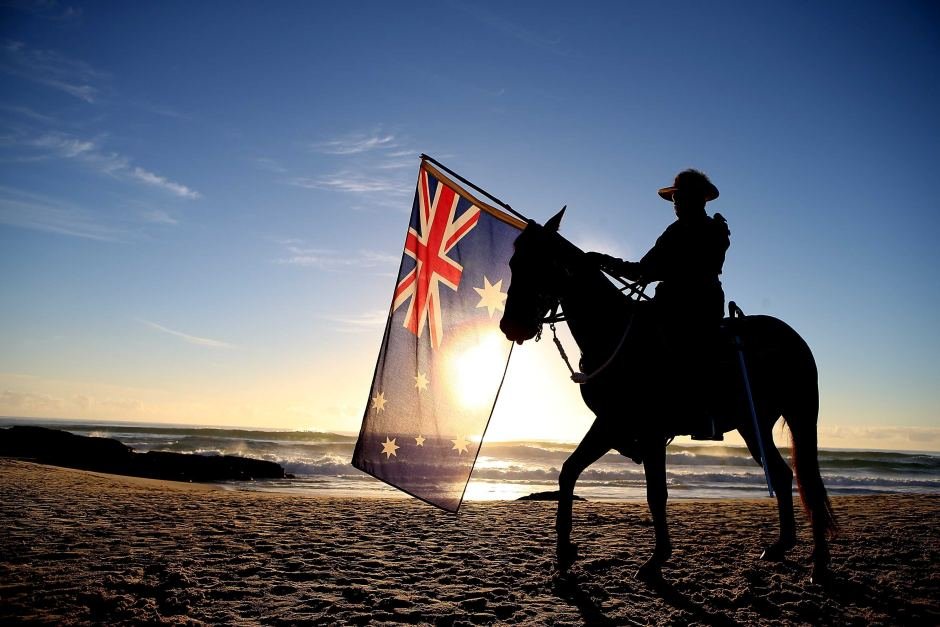
The last drops of water dribbled from the canteen into the depression he'd made in the top of his slouch hat and he held it down for Bessy to drink; There wasn't much but the horse lapped it up eagerly. Her head was bowed; Fatigue, thirst and the oppressive desert heat bore down like hammer on anvil. It was relentless. The 48-hour forced-march didn't help. She'd carried the trooper stoically though, a real Australian battler, and she'd be right he thought as he patted her neck...Come tomorrow she'll be ready - The trooper secretly hoped he'd measure up to the task too - He wasn't afraid, just fearful of letting his mate's down. They were attacking Beersheeba tomorrow and he couldn't let his mates down - He wouldn't...
Last week @nonameslefttouse suggested a new tag with the hope of generating activity on Sunday's. He suggested re-working a loved-post from the past and showcase it on a Sunday. You can see the post nonameslefttouse made introducing the concept here , I suggest you read it as he set some guidelines and simple copy-paste of an old post is probably not legit.
This post was originally written and posted by me on the 22nd August 2017 and I have gone through it and cleaned it up, reworked and added to it in places, plus added the italicised paragraph at the top of this post by way of a little lead in. [Amazing how many errors I found in the original and how badly I wrote it two years ago.]
Anyway, here's the rework.
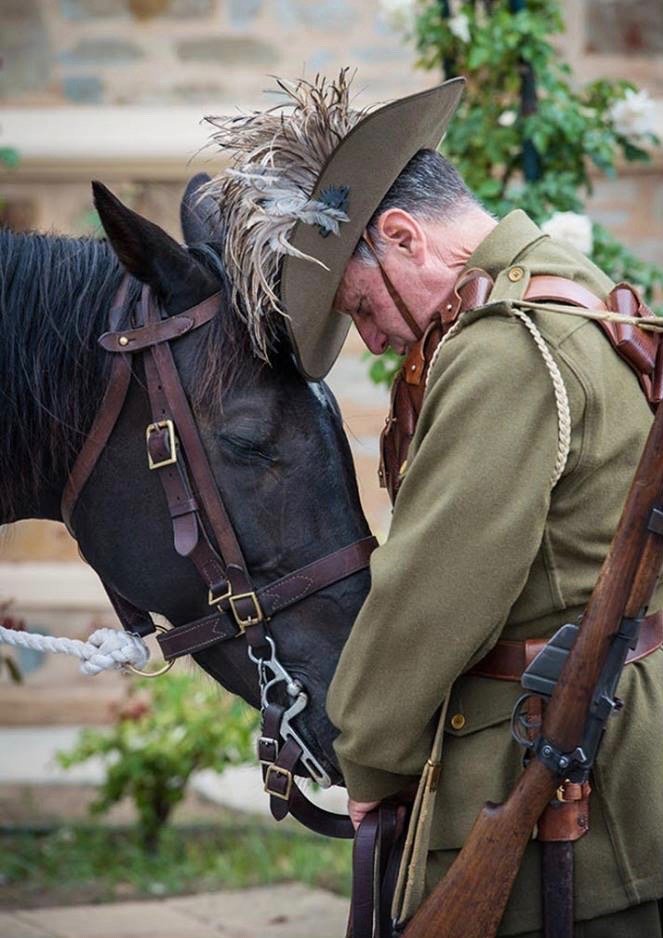
This is a tribute to the Australian Light Horse, the men and their mounts; They are gone now, dead one and all, but they live in my memory. It's sad at the end, but an important part of Australian history...These men and horses deserve to be recalled. src
1899 Boer War
War broke out between the Boers [Dutch farmers in South Africa] and the British Empire. Australia, then a colony of Britain were required to send troops, and they did; Not just any troops though. They were called The Light Horse and ultimately proved to be a very effective fighting force against the Boers; Highly mobile, lateral thinkers and expert marksmen. They were, essentially mounted commandos due to their ability to ride and shoot extremely well, insert into the field quickly and operate against the Guerilla force, being the Boers.
They acquitted themselves with honour and returned home an experienced and decorated unit. In 1901 Australia became a Commonwealth and the foundation of what is now our military forces was laid, the celebrated Light Horse among its numbers.
1914 - First World War
The Light Horse answered the call again shipping off to distant shores. There were 23 Light Horse regiments made up of militia volunteers [A reservist force] and the men of these units flocked to join the AIF - Australian Imperial Force, Australia's regular army. The excitement the war was sure to provide being a big attraction. Besides, it would be over by Christmas - Most subscribed to this general consensus. [People thought differently back then and every single Australian soldier who went off to the First World War were volunteers.]
Initially 4 regiments, totalling 2000 men, were promised to the British but by the end of the war sixteen regiments were in action; Thousands and thousands of men and mounts.
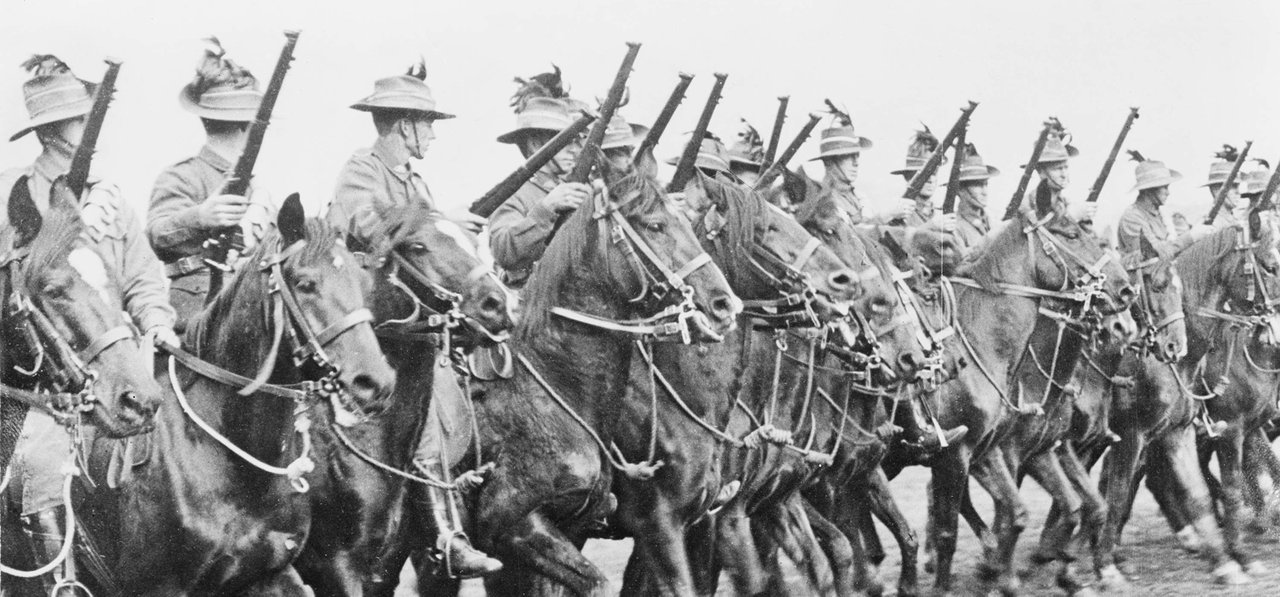
The mounts
The horses used, gathered from across Australia, were known as walers as that's where the breed originated from, New South Wales. These were good sturdy horses with big hearts, great speed, stamina, intelligence and immense strength. Some of the troopers brought their own horses and, if deemed suitable by army veterinarians, the AIF would pay about $60 or so for the animal and enlist it. Remounts were purchased from graziers and breeders on a constant basis to replace those fallen. The story of the sourcing of these animals is legendary and maybe one I'll elaborate on someday. This image courtesy of the Australian War Memorial
The Light Horse Trooper
This tough Aussie bloke was required to carry everything he needed on his person or horse and an impressive array of items was packed, strapped and bundled on board with great care.
The walers carried some 130-150 kilograms when fully loaded and sometimes for up to 60 hours at a time, in desert conditions, with little or no water. They were impressive animals and their rider, the trooper, would care for his animal with extreme diligence and care. They loved their horses in truth and in times where water was scarce would often water the horse and go without water themselves - The way of the Light Horse. The bond of horse and rider was unique and incredibly strong; Only death broke it.
The troopers were capable of acting independently of command meaning they were an effective force even if they lost a superior. They would simply see what needed to be done and go and do it. This characteristic was intrinsic to every Australian soldier - A by-product of the independent thought they had to apply back home in what was a harsh unbroken land at the time.
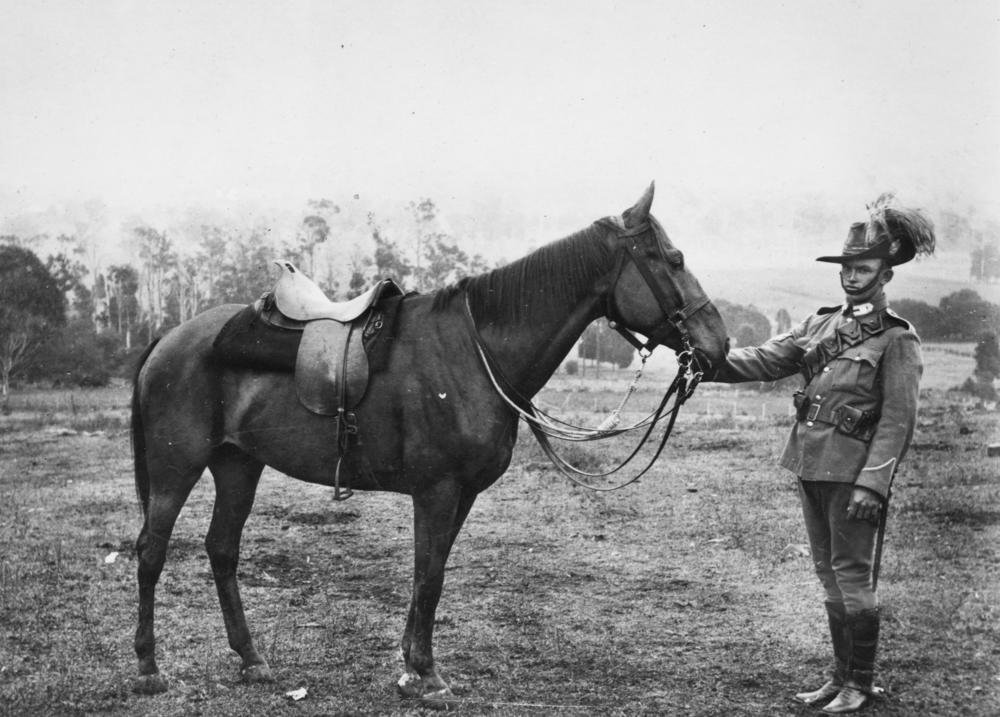
Light Horsemen wore a unique hat plume on their slouch hats. It's an emu feather of course but the blokes, being Aussie's and known to tell a yarn now and then, thought it was funny to tell people they were kangaroo feathers. [Kangaroo's of course, don't have feathers - In case you didn't know. They're not birds you see.]
I believe the plume-tradition originated from these men wanting to display their skill at horsemanship. They would chase down an emu, on horseback to the hoots and hollers of their mates, reach down and pluck their plume from its back, all at a full gallop. Not an easy task I'm sure. Image is Sergeant Herrmann (Harry) Topp of the 2nd Light Horse Regiment. src
The Light Horse (4 regiments) were deployed to England, destined for the Western Front in Europe with grand visions of sweeping cavalry charges and glory. They boarded transport ships and steamed away from home. How many would see it again?
Whilst on the transport ships troopers spent 10-12 hours a day tending to their horse greatly reducing the death-rate however some still died in transit - A tragic blow for the trooper who would have to be issued a re-mount and start the bonding process all over again.
In war rarely does a plan survive contact with the enemy and naturally things changed. The Light Horse were re-routed to the deserts of Egypt then were eventually sent to Turkey and the infamous and ill-fated Gallipoli campaign. Of course, their horses would be no use on the steep cliffs and terrain of the Gallipoli Peninsular, so they remained behind in Egypt. The men were not happy about it but were left with no choice. It was heartbreaking but the men were eager to get at the enemy so they said their goodbyes and deployed to Gallipoli joining other elements of the AIF.
I won't go into details in this particular post but it was the Light Horse who fought the battle of the Nek on the Gallipoli Peninsular. [Just one encounter over the 9 month debacle]. A diversionary battle, the Nek was designed to take enemy focus off a British landing in another area.
Four waves each of 150 men went over the top, climbing over the trench parapets, and charged the Turkish machine guns (seven trench-systems deep), one after the other, over 45 minutes.
The first wave made it to the top of the trench and were butchered, torn apart by machine gun fire. Each subsequent wave dutifully went over the top as well though; These men took their responsibilities seriously, despite knowing the likely outcome. There was no way they'd let their mates down. In three quarters of an hour 234 troopers were killed and 138 were wounded terribly, many to die later, often laying out in no mans land between the trenches baking in the heat.
Some survived the debacle that was the Gallipoli campaign and made it back to Egypt but many horses looked expectantly for their troopers only to find he had died in Gallipoli with thousands others of AIF soldiers.
The desert deployment
Reunited with their horses back in Egypt after the Gallipoli horror show (brought about by British-command foolishness) the Light Horse would distinguish themselves in the Sinai, in defence of the Suez Canal; Critically important for allied transport and shipping movements. They fought in Palestine, Gaza, Beersheba and a myriad of other places. Their adversary were combined German and Turkish forces and they all had the Gallipoli campaign [defeat] in mind, and were keen to even the score. Fighting was brutal and conditions for man and horse were terrible; Hot, dry and dusty. But these men and horses were tough and each came to rely on the other equally. Their lives depended on it.
Beersheeba
One of the most retold and celebrated battles the Light Horse fought was the charge at Beersheba. The objective: 17 water-wells within the town of Beersheba held by the Turkish and a scattering of Germans. It was water the 60,000 men, and twice as many horses, desperately needed. Not taking Beersheba meant the end of the Light Horse, and a significant setback for the allied war in the desert. It was charge and take the town before the wells were blown up; Or die as they wouldn't reach water in time to save men and horses.
31st of October 1917 - The battle
Some objectives were secured over the day but by late afternoon Beersheba, and the entrenched defenders, still held out. The horses and men had now been without water for almost 48 hours and were on the edge of collapse. The commander of the 4th Light Horse, Brigadier General Grant, suggested to his commander, General Chauvel, that a mounted charge across over three kilometres of open ground by two regiments would do the job. Madness! But Chauvel agreed; His troopers would do what was required. Utter confidence.
The defenders within Beersheba? Firmly entrenched, supported by machine guns, artillery and aircraft. The Australian's had a fierce reputation though so I assume the defenders were not all that confident, but they had trenches and overwhelming numbers.
A three-line charge-formation was assembled and the troopers advanced at a walk, trot and canter the closer the came. They advanced into withering machine gun fire and deadly shelling.
At about two kilometres from the enemy trenches the Light Horseman charged at full gallop. Swords or bayonets were drawn and the wild-eyed Australian's shouted their battle cries, standing and leaning forward in saddles! With artillery lobbing shells on their heads, two German planes machine-gunning from on high and thousands of enemy troops firing rifles and machine guns from their entrenched positions they thundered towards the enemy. Take the wells, or die...And the battle joined.
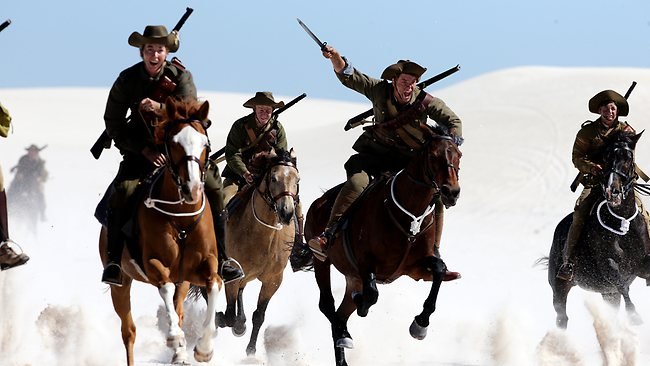
Casualties were light surprisingly; The fearsome sight and sound of these crazy "Kings of Feathers," as the Turks called the Australian Light Horse, (referring to the plume they wore), unnerved the defenders and soon the Light Horsemen were leaping over trenches towards the well-objective's. The Turks had wired the wells with demolition charges so it was imperative to prevent them being set off. Some wells and buildings were destroyed but eventually the German commander was captured by a bloody Aussie hero Light Horseman and the objective was secured along with many many prisoners. above im src
It must be said that very early on the 31st the British 20 Corps were ordered to take Beersheeba but after almost a full day of attack they were unsuccessful. That's when the 4th and 12th Light Horse Regiment's were ordered to attack and in less than an hour Beersheeba had fallen.
Of the 800 Light Horsemen that charged Beersheba only 31 lost their lives. Remarkable considering the odds stacked against them. The speed and endurance of their mounts contributed to the low casualty-rate. The horses had acquitted themselves well and had bravely carried their troopers into battle once again. It was one of the most successful cavalry charges in history, and the men and mounts could drink their fill. Horse first, man later as was the way of the Light Horse. [The charge was supported by British artillery which also positively affected the outcome - Thanks Brits.]
As this is such a long post I won't go completely into the full history of the Light Horse but I want to finish with what I feel is the most tragic part of their history.
Tragedy strikes the Light Horse
Of the thousands and thousands of walers that left Australia to go to war...The horses that had so gallantly and bravely carried their troopers into battle, through the desert, bullets, bombs and hardships of war...Well, not a single one ever came home. Not one. Not a single Australian horse came back to gallop the vast brown land of their birth, under blue skies and tall gum trees.
The government decided due to quarantine regulations and cost they had to remain in Egypt; Tens of thousands of them. These noble and proud animals would end up staying in Egypt and pulling a plow or cart, or die; Glories of their war-days and bravery long-forgotten or never known in the first place. As one trooper wrote:
Just crawling around old Cairo with a Gypo on his back.
Perhaps some English tourist out in Palestine may find
my broken-hearted waler with a wooden plough behind."
[Gypo's is what the Aussie's called the Egyptians.]
An order came down the line that each horse was to be classified A,B,C or D with all C and D horses to be shot. The A's and B's were sold to locals for plough horses or beasts of burden. The process involved removing their shoes, manes and tails because these were saleable items. They'd then be shot and...Skinned for their leather. Brave walers, soldiers of Australia, who had so gloriously and loyally served. Tragic.
Thousands and thousands of them were shot; Taken to olive groves beyond Tripoli, given a last nosebag of fodder and unceremoniously shot in the head. Bang, you're dead beast!
They went to their deaths without fear too, not knowing it was coming. They trusted these familiar uniformed-men and the sound of gunfire held no fear for them after so long on the battlefield. They were trusting to their dying breath. There was no honoured grave for these soldiers, no bugle playing the last post to mark their passing, just an ignominious death.
Some of the troopers thought it was less-cruel for their horse to be shot than cruelly treated by a new owner for the rest of their life. Some blokes asked to take their mount for a last ride coming back carrying only a saddle then lying to superiors that his horse had stepped in a hole and needed to be shot. Can you imagine doing that? Taking your horse, your trusted friend who had carried you into and out of battle, out to shoot it yourself? I guess they would rather have done it themselves though and save the horse the indignity of being shorn and skinned.
It was a brutal and senseless end to such loyal mounts, one that came about because the Australian Government didn't want to spend the money to bring them home.
So, there's a story about The Australian Light Horse; A very cut down and shortened version.
The men and horses hold a special place in our hearts here in Australia. But I guess that's even changing with the influx of new Australian's who don't know or understand our histories. It's a damned shame.
Every ANZAC day I attend the dawn service at the war memorial then head to East Terrace for the service for the horses of the Australian Light Horse. People take carrots and apples and leave them at the monument. Horses love carrots of course. At the end of the day piles of carrots and apples get taken away and given to the police mounted-division horses. A nice gesture.
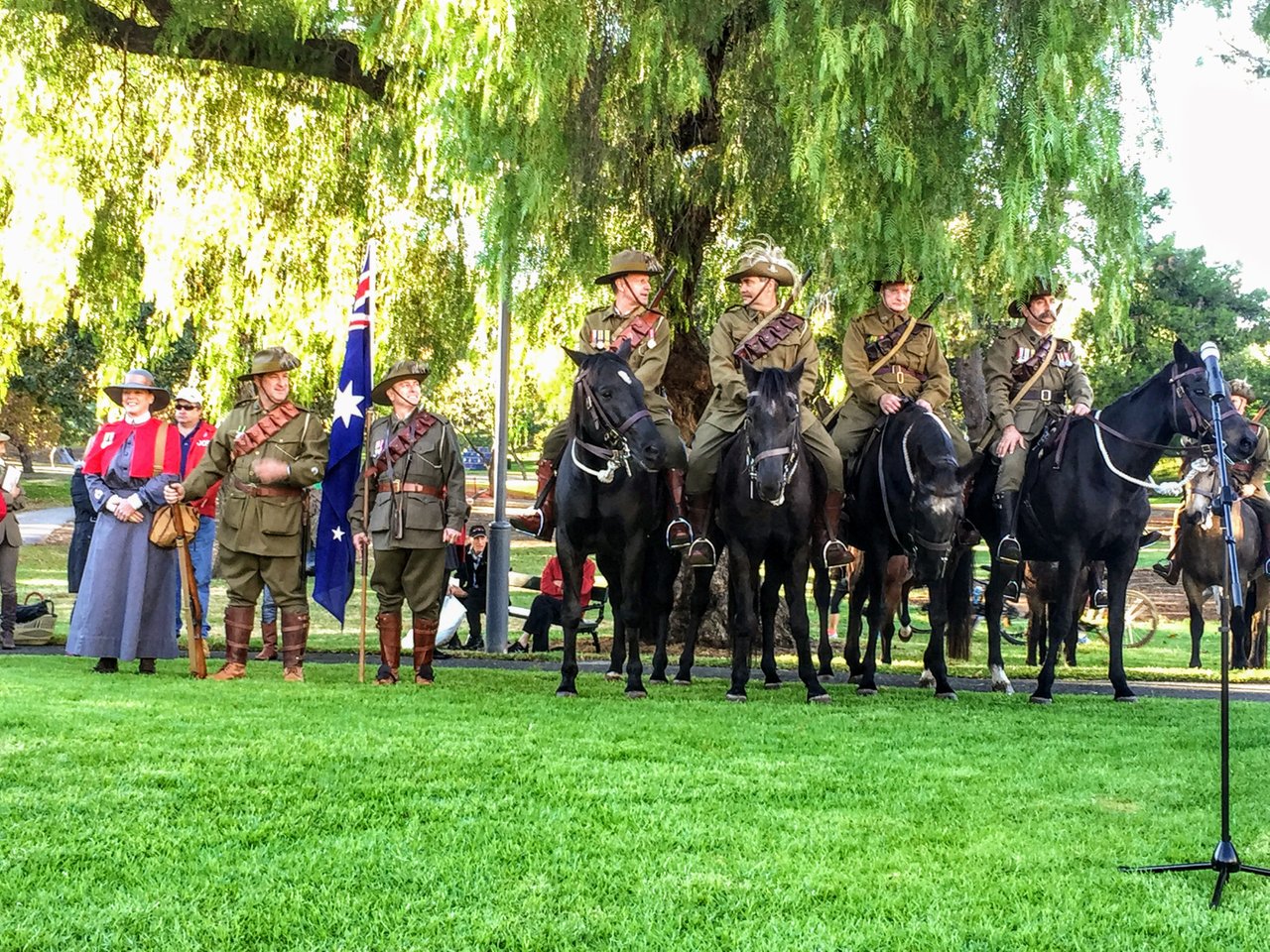
I took this image on ANZAC Day at the Light Horse Memorial. This is the Barossa Light Horse, a group who recreate's the Light Horse and attend services like this one - Keeping the legacy alive
Here's a YouTube trailer of an Australian movie made some time ago about the charge at Beersheba. The movie is called The Light Horsemen. If you take the time to watch the 10 minute trailer you'll get a really great idea of what it was all about to charge into battle on a horse - And some great Aussie accents.

War is terrible. It is tragic, wasteful and sadly quite probably avoidable. I think about the men and women who go to war, and thank them for the sacrifice they make. Who remembers the animals though? The horses in the case of the Light Horse, but these days working dogs; Attack and bomb detection dogs...Well, I remember, as should we all.
Lest we forget
Thanks for reading all the way to the end - 2,900 words is a lot, I know. I really appreciate it if you did. Thank you.
Original post was posted on my blog 22 August 2017 and can be found here
Design and create your ideal life, don't live it by default
Discord: @galenkp#9209 🇦🇺
@curangel curator
Flag image - Getty Images: Chris Hyde.
